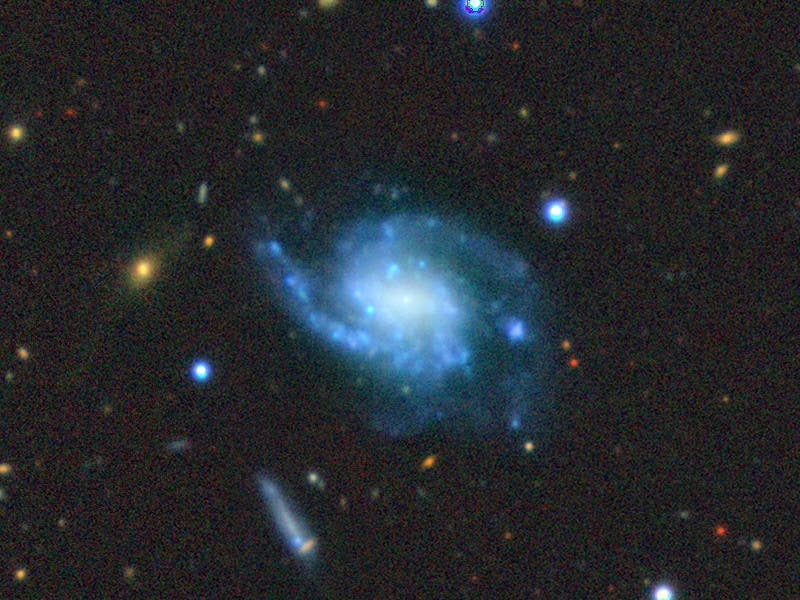Brightest fast radio burst ever detected traced to nearby galaxy
The brightest fast radio burst ever detected catalogued as FRB 20250316A has been traced to a galaxy 130 million light-years away.

Spiral galaxy NGC 4141. (CREDIT: Legacy Surveys / D. Lang (Perimeter Institute))
Astronomers have just caught the brightest fast radio burst (FRB) ever recorded, and it has been given a nickname worthy of its power: RBFLOAT, short for “Radio Brightest Flash Of All Time.” The extraordinary event, formally catalogued as FRB 20250316A, was spotted this past March by the Canadian Hydrogen Intensity Mapping Experiment, better known as CHIME. This massive telescope in British Columbia has made a name for itself by finding thousands of FRBs, but none quite like this one.
What makes the discovery stand out is not just the intensity of the flash, but the precision with which scientists traced its origin. Normally, astronomers can only place an FRB somewhere within a vague patch of sky, far too wide to reveal much about its birthplace. This time, they narrowed it down to a region only 45 light-years across within a spiral galaxy called NGC 4141, about 130 million light-years from Earth. For perspective, that’s like being able to see a quarter from 62 miles away.
How CHIME Stepped Up Its Game
The leap in accuracy came thanks to a new upgrade. CHIME was joined by three smaller “outrigger” stations, scattered across North America from California to New Brunswick. Together, these instruments act as a continent-wide telescope, boosting the system’s sharpness and giving astronomers the ability to trace FRBs back to the galaxies—and even the neighborhoods—where they occur.
Shion Andrew, a graduate student at MIT’s Kavli Institute for Astrophysics, put it simply: “Localizing an FRB to a specific part of its host galaxy is analogous to figuring out not just what tree the firefly came from, but which branch it’s sitting on.”
The outriggers proved their worth when CHIME caught RBFLOAT’s millisecond-long flash. At first, the signal was so bright that some wondered if it was interference from Earth, like a spike in cellular traffic. But the array quickly confirmed the source was cosmic, and pinpointed NGC 4141 in the constellation Ursa Major as the host galaxy.
A Neighbor in Cosmic Terms
While 130 million light-years may sound impossibly distant, astronomers consider this FRB practically next door compared to most, which usually come from billions of light-years away. “Cosmically speaking, this fast radio burst is just in our neighborhood,” said Kiyoshi Masui, an MIT physicist and co-author of the study. That closeness, paired with its dazzling brightness, offers a unique chance to probe the mystery of FRBs in fine detail.
Related Stories
- First-ever fast radio burst (FRB) found in an ancient, elliptical galaxy
- New fast radio burst detector is reshaping our understanding of the universe
The team’s results, published in The Astrophysical Journal Letters, describe how the burst was found near the edge of a star-forming region within NGC 4141. The location hints that the source could be a magnetar—an ultra-magnetized neutron star—possibly one that is slightly older than the youngest stars still forming at the galaxy’s center. Masui explained it this way: “If it were right in the middle, it would only be thousands of years old. This one, being on the edge, may have had a little more time to bake.”
A Glimpse with the James Webb Telescope
Because CHIME and its outriggers locked in so quickly, astronomers were able to alert the James Webb Space Telescope (JWST) to take a closer look. Webb’s infrared cameras picked out a faint point of light, dubbed NIR-1, sitting near the burst’s position.
What exactly is NIR-1 remains uncertain. It could be a red giant star, an evolved sun-like star that has ballooned in size, or perhaps a massive star in its midlife. Either way, these stars are not typically linked to FRBs. That has led some researchers to suggest NIR-1 might be part of a binary system with a compact partner, like a neutron star. The interaction between the two—say, the giant star feeding material to its dense companion—could explain the radio outburst.
Another idea is that NIR-1 isn’t a star at all but rather the lingering glow of the burst itself. If the object fades over time, that interpretation may gain strength. Either way, the combination of CHIME’s precision and JWST’s sharp vision has delivered a rare view of the possible birthplace of an FRB.
Peter Blanchard of the Harvard-Smithsonian Center for Astrophysics emphasized the importance of the find: this may be the first time an object has been linked to an FRB in another galaxy. His colleague Edo Berger called it “the first step on a new path toward solving the mystery of FRBs.”
Do All FRBs Repeat?
One of the big questions in FRB science is whether these flashes come from one-time events or repeat over time. Since their discovery in 2007, astronomers have recorded more than 4,000 FRBs. Most are one-offs, but a small fraction repeat, and a handful of those even show patterns.
The team behind RBFLOAT combed through six years of CHIME data, looking for any previous signals from the same spot. They found none. So for now, RBFLOAT seems to be a one-time event. That makes it especially interesting, since its closeness allows astronomers to study the surrounding environment in greater detail than ever before.
Adam Lanman, a postdoctoral researcher at MIT, noted that this is helping scientists see just how diverse the environments of FRBs can be. Some come from young, active star-forming regions. Others, like RBFLOAT, sit just outside. Gathering more examples will be key to figuring out whether repeating and nonrepeating bursts share the same origins.
Why This Discovery Matters
FRBs remain among the most puzzling phenomena in modern astronomy. They last only milliseconds, yet during that flash they can shine brighter than every other radio source in their galaxy combined. Because they travel across such vast distances, they also serve as probes of the space between galaxies, carrying clues about the matter scattered through the universe.
The record-breaking burst not only provides new leads about what powers these cosmic flashes, but also shows how powerful collaboration between telescopes can be. The swift combination of CHIME’s detection and JWST’s imaging paints a roadmap for future discoveries.
Practical Implications of the Research
The ability to localize FRBs with this level of precision has wide benefits. It allows scientists to probe not only the sources themselves but also the material the signals pass through on their way to Earth. This could help chart the otherwise invisible matter that makes up much of the universe.
For everyday life, insights from FRBs may eventually improve technologies that depend on radio wave science, such as advanced communications.
Most importantly, the research demonstrates how rapid teamwork between observatories can unlock mysteries faster, setting the stage for future discoveries that deepen our understanding of how the universe works.
Note: The article above provided above by The Brighter Side of News.
Like these kind of feel good stories? Get The Brighter Side of News' newsletter.



